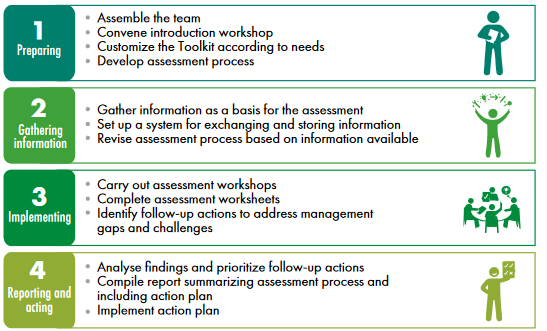Enhancing Our Heritage Toolkit 2.0 is updated to measure the effectiveness of World Heritage management systems, with a World Heritage-specific management effectiveness assessment methodology applicable to cultural, natural, and mixed sites.
By
Advisory Bodies to the World Heritage Committee
ICCROM (International Centre for the Study of the Preservation and Restoration of Cultural Property)
ICOMOS (International Council on Monuments and Sites)
IUCN (International Union for the Conservation of Nature)
You will find:

Self-Assessment Methodology: An internationally tested methodology for self-assessment that helps World Heritage managers and actors evaluate the management effectiveness of a World Heritage property or other place of heritage
Management Effectiveness Assessment: determines how well a World Heritage property is being managed, primarily by examining the extent of its heritage values preservation and its management objectives accomplishment.
Identify conservation practices, management processes, and resource allocation to improve, especially before reviewing or updating management plans.
“12 tools to assess how well a World Heritage place is managed”
-
Values, attributes and management objectives: Examines how well the management system understands the heritage place values and whether its objectives are appropriate
-
Factors affecting the property: Determines whether the impacts of specific factors on the property or heritage place are well understood, well documented, and sufficiently addressed in management measures
-
Boundaries, buffer zones and the wider setting: Evaluate the appropriateness of the configuration of the heritage site, its interactions with its buffer zone and wider setting
-
Governance arrangements: Checks whether the roles and responsibilities of different managers are clear, whether they are cooperative, and whether rights-holders are involved in the management of the property
-
Legal, regulatory and customary framework: Assesses how the heritage place is managed based on policies, legislation, customary practices, and other legal and regulatory tools
-
Management planning framework: Analyses the effectiveness of the planning framework and determines the adequacy of the management plan, guiding management
-
Needs and inputs: Evaluates the current human capacity and the financial, material, and technological resources needed for effective management of the property
-
Management processes: Checks if policies and procedures exist to ensure that processes are executed according to good practices and desired standards, and determines whether management processes are appropriate
-
Implementation of management measures: evaluates how well the management plan, subsidiary plans, and relevant work programs are being implemented
-
Outputs – Monitoring productivity: Provides feedback on the effectiveness of planned actions, routine work, and management processes
-
Outcomes – Monitoring the state of conservation: Monitors the property’s conservation status and value to determine if it is being conserved and maintained
-
Review of management effectiveness assessment findings: Describes the findings of the assessment and helps prioritize future actions
The first toolkit
Enhancing our Heritage Toolkit was first published in 2008, and is based on the Framework for Assessing the Management Effectiveness of Protected Areas of the IUCN World Commission on Protected Areas (Natural Heritage). Within the revised edition, ICOMOS has further expanded and reinforced the potential for use with cultural properties based on work done under the Connecting Practice project in 2016-2017.
Our take
The toolkit offers an updated opportunity to streamline World-Heritage management and provide assurances that shortly the value of our collective heritage will be equally safeguarded and enjoyed by all.
Furthermore, the methodology is designed for all heritage sites, including cultural and natural ones, and is applicable internationally, nationally, and locally, focusing on World Heritage sites. Unlike other methodologies that require external support, validation, or information sharing, the toolkit is self-assessed and was developed by and for managers, with 12 effective and multidisciplinary tools!
And of course our favourite:
Participatory processes are used to help you better understand why certain aspects of the management system might be underperforming.
I want to learn more:

